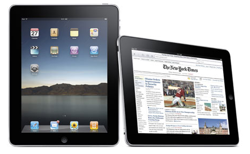Do you want to buy an e-reader, like the Kindle, or maybe a tablet computer, like the iPad or the Galaxy Tab? Consumer Reports has advice on just what to consider. Here’s the scoop from Consumer Reports:
- E-book readers are best for books.
An e-book reader remains the best choice if reading books is the top priority for a new device. Its lighter weight makes it more comfortable to hold during sustained reading and the text on an e-ink screen is easier to read than the text on tablets’ LCD screens, especially if plans include reading in bright light–as, say, on the beach. - Tablets offer more reading versatility.
A tablet is generally better-suited for reading e-magazines and e-newspapers. The iPad has by far the most access to magazines designed for the tablet experience. Plus, most tablets offer downloadable apps from Kindle, Nook and other digital booksellers that allow consumers to read e-books with the versatility of a tablet device. - Choose a screen size and shape.
Most screens on e-book readers and tablets are 6 to 7 inches or 10 inches. For e-book readers, Consumer Reports recommends the smaller size range. With a tablet, the extra real estate of a 10-inch screen better suits such activities as Web surfing, video views and gaming. The iPad and most e-book readers have squarish screens which Consumer Reports found to be better suited to more tablet uses than rectangular screens. For e-book reading, screen shape is a matter of personal preference. - Opt for Wi-Fi connectivity.
All but a few low-rated devices Consumer Reports tested offer Wi-Fi connectivity. Most of the higher-rated devices also come in a version that can access cellular data networks as well as Wi-Fi. - Consider apps selection for tablets.
To make the most of a tablet’s capabilities, consider that there are a far greater breadth of apps available for iPads than for other tablets, though those competitors (especially those that use the Android operating system) are steadily expanding their selection.



Comments are closed.